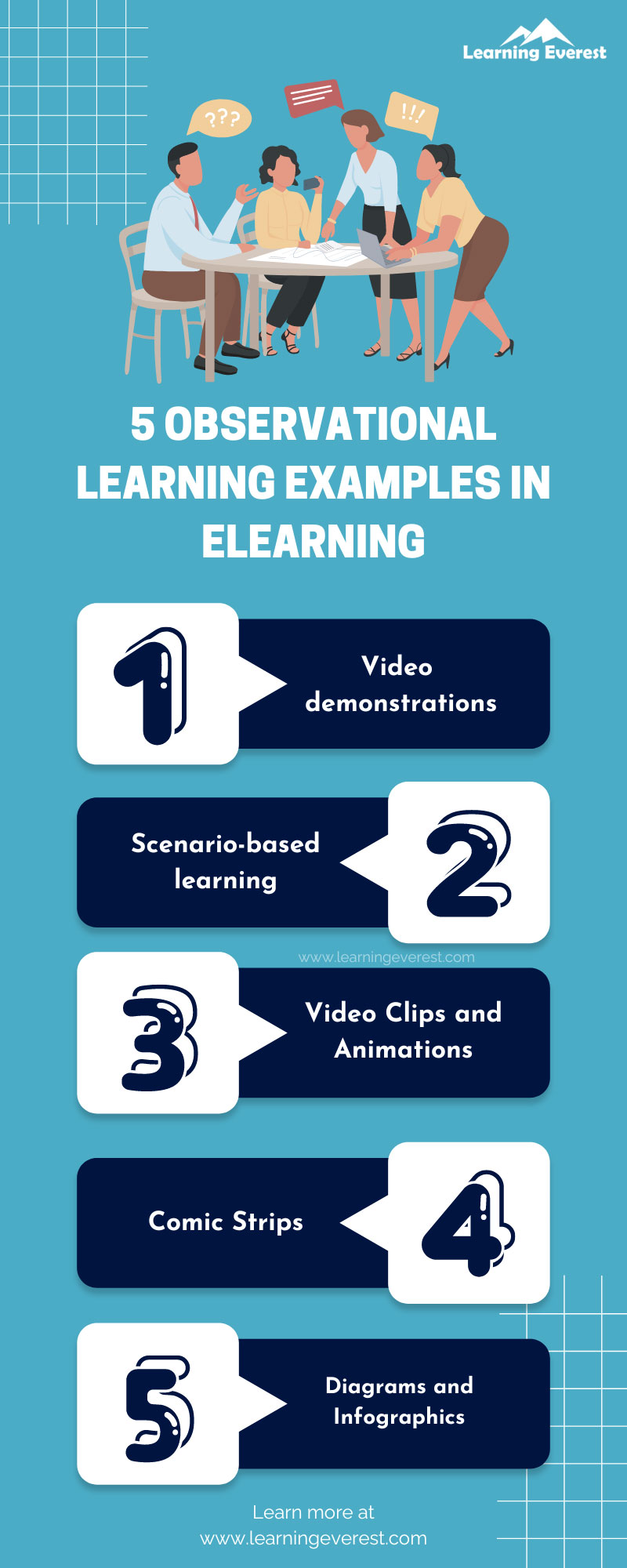Observational learning is a mechanism of social learning wherein people learn by watching and imitating behaviors. It is a core component of Albert Bandura’s social learning theory. Observational learning enables individuals to learn from their environments, allowing for the transfer of complex and nuanced knowledge and skills. In eLearning, observational learning serves the same purpose. This article will present you with 5 observational learning examples that you can use in your eLearning programs for greater course efficacy.
What is Observational Learning?
Observational learning is learning by observing others’ behaviors and their consequences. The individuals being observed serve as models, demonstrating which behaviors have positive outcomes and which ones don’t.
Effective observational learning takes place in 4 stages:
1. Attention
An individual must be paying attention to the behavior of others in order for them to learn from them.
2. Retention
After observing a behavior, it is crucial that the observer also retains it so it can be used in the future.
3. Reproduction
Once a behavior has been retained, learners need to reproduce it. Depending on the complexity and the learner’s own unique strengths and weaknesses, it might take them a single try to multiple tries to master the behavior they are reproducing.
4. Motivation
Lastly, a learner’s desire to learn behavior plays a central role in whether they will retain and reproduce it. If a learner is not motivated, chances are that they might not pay attention to the behavior at all, or make no attempts to remember it.
Observational Learning Examples in eLearning
Let us now look at observational learning examples in eLearning.
Video demonstrations
Video demonstrations illustrate how a particular behavior is to be carried out. It may have on or more models who teach the various types of a behavior, the correct order of steps to complete a behavior, and/or the right or wrong way to carry out a behavior.
Video demonstrations are a great tool for teaching learners social skills or practical information such as procedures.
Scenario-based learning
Scenario-based learning uses specific situations to build learners’ knowledge and skills. It can be carried out in a few different ways:
- Presenting a complete scenario with a clear outcome and lesson
- Using fictional models to demonstrate desired and undesired behaviors
- Letting learners navigate through a scenario by roleplaying, making choices, and observing consequences
Scenario-based learning is also highly immersive and engaging, creating the conditions necessary for effective social learning to take place.
Video Clips and Animations
Apart from demos, videos can also be used as a tool for observing real situations, such as an interview, customer enquiry, etc. Animations can serve the same purpose. This kind of observational learning is great for building soft-skills like communication skills, emotion recognition, problem-solving, negotiation skills, etc.
Videos can be scripted or real-world clips of actual employees carrying out their duties. Animations are most often scripted, even when based on a real situation, as it requires prior thought and planning.
Comic Strips
Comics are another great tool for facilitating observational learning. Comics depict fictional characters engaging in certain tasks. They utilize visual storytelling to build a clear narrative where learners can clearly observe the cause and effect between the characters’ behaviors and choices. Comics are also short and engaging, imparting knowledge and skills in a quick and interesting manner.
Diagrams and Infographics
Another way to facilitate observational learning is through diagrams and infographics. These resources typically depict illustrated or real people interacting through dialogue boxes. The depictions are dynamic, clearly conveying the emotional tone between the characters through facial expressions and symbols. Additionally, there is commentary, information, and tips regarding the situations being depicted, to let learners know the dos and don’ts of the situation.
Conclusion
Observational learning is a valuable form of learning. It builds soft skills, as well as practical skills, and enables learners to develop a complex awareness of the world. Observational learning also provides clear references that can be replicated without the learner having to additionally process the information, making it a quick form of knowledge transfer. With observational learning, learners develop actionable skills and problem-solving capabilities, making them dynamically competent in the target behaviors. With the strategic use of multimedia, observational learning can easily be incorporated into eLearning, making it a rich, immersive, and meaningful experience for learners. The observational learning examples covered in this article also help create highly effective training programs, ensuring high ROI for businesses and institutions.
Infographic

Observational Learning Examples in eLearning
Knowledge Check!
Frequently Asked Questions (FAQs)
What is an example of observational learning?
Some observational learning examples are:
- Video demos
- Scenario-based learning
- Video clips and animations
- Comic strips
- Diagrams and infographics
What is observational learning?
Observational learning is learning by observing others’ behaviors and their consequences. The individuals being observed serve as models, demonstrating which behaviors have positive outcomes and which ones don’t.





